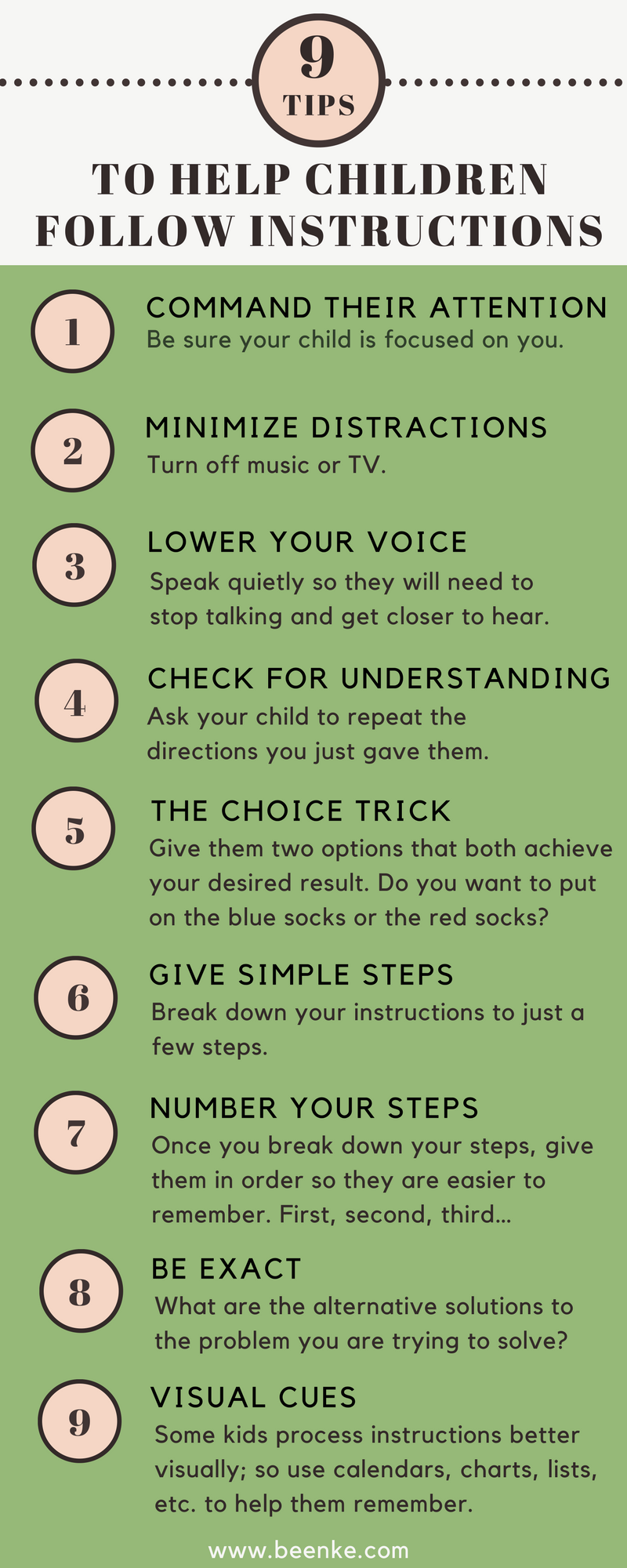Trying to get children to follow instructions can be completely exhausting! Am I right? Almost every parent I know has wondered how to get kids to listen at some point.
Especially after repeating the same directions, over and over again, without getting better results. I start to sound like a broken record!
After a particularly frustrating battle of wills one morning getting my child ready for school, I knew there had to be a better way.
I started thinking about who might have some brilliant insights into how to get kids to listen.
Who has mad skills when it comes to helping children follow instructions? Then it hit me….TEACHERS, that’s who!
Teachers sit in a room full of kids ALL DAY LONG. Children who need to listen and follow their classroom directions to make the day go smoothly. And they survive!
How do they do it? What’s their secret?
We asked.
First, they say, you need to understand where your child is developmentally so you know what level of instructions they will be able to hear and follow.
In other words, directions should be age-appropriate!
Second, they gave us some great tips to on how to get kids to listen and follow instructions that totally work in the classroom, and they can work for you too!
Read on to learn their secret sauce.
How To Get Kids To Listen
Step one is to ensure that the instructions you give your kids are tailored to their age and development level.
The teachers we spoke with said you can talk until you’re blue in the face, but if a child us not up to a task maturity-wise, they won’t be able to complete it.
In other words, consider your kids’ level of understanding before you start directing them.
The Development Of Following Directions
For children, following instructions is part of language development and it’s a skill that develops with age and maturity. Here’s a general guide to keep in mind.
Age 1: Children can understand and respond to easy one step directions such as handing you a towel when you ask for it, or sitting down when you say “sit please”.
Age 2: Your child can identify certain objects or body parts which, as you can imagine, is a serious help for getting children to follow instructions.
Age 3: Children start to understand and carry out more complex two step directions, such as “please pick up all your toys and put them in the toy box.”
Age 4: Children can identify SOME shapes, colors, and letters which are very important skills for being able to follow directions.
Kids this age can also follow more complex directions, such as three or four step directions. And they will begin to ask questions if they don’t understand something.
Keep in mind, If your child has developmental or cognitive delays, it may take them a little longer to reach each stage. You’ll need to set expectations based on where they are developmentally, not just by their physical age.

9 Tips To Help Children Listen And Follow Instructions
Let’s get down to the nitty-gritty. Want to know how to get kids to listen and follow instructions?
It seems like a huge challenge, but it doesn’t have to be. Our teacher informants shared their best tips that work in the classroom, which parents can easily use at home.
Here are the top 9 useful tips to for getting kids to listen and follow instructions.
1. Command Their Attention
Giving directions when your child isn’t focused on you is a recipe for disaster. Before you give instructions, ask for your child’s attention.
RELATED: End The Power Struggle! Top 6 Ways To Get Kids To Cooperate
“Look toward me please”, or “I need you to listen now” are good attention commanding statements.
Your kids don’t need to look your direct in the eyes, if eye contact makes them uncomfortable, but they do need to be actively paying attention.
2. Minimize Distractions
Once you’ve commanded your child’s attention, you want to keep it!
It’s hard for anyone to focus when there’s a lot of stimuli competing for their attention, especially kids.
To help children follow instructions be sure there are no distractions.
Turn off the TV or radio. Ask your child to put away any game, book, or toy they might be playing with. And you do the same.
Model the appropriate behavior by giving your child your full attention when giving directions. They’ll know what you’re saying is important!
3. Lower Your Voice
You might feel the impulse to talk louder than your child or yell when you need something to get done… but this can actually backfire and get your kids to tune you out.
It seems counter-intuitive, but when researching how to get kids to listen, lowering your voice is a tactic that works.
RELATED: 21 Ways To Stop Yelling At Kids
Give directions in a calm and even tone. Your kids will need to come in close and stop talking to hear what you’re saying.
This encourages them to pay attention. It’s kind of like a Jedi-Mind trick that teachers use all the time.
4. Check For Understanding
Give your child a minute to process the instructions you just gave them, and then ask them to repeat the directions back to you.
RELATED: Top 12 Ways To Improve Your Parenting Skills Today
This will help you gauge whether they understood what you’re asking. It also gives your child a chance to ask questions.
5. The Choice Trick
Don’t ask your kids to do something, tell them. After all, listening and following instructions isn’t up for debate.
Kids might push back, however, if they feel like they have absolutely no control…and that’s where the choice trick comes into play.
RELATED: Getting Kids To Listen: It’s Possible, We Swear!
Instead of telling your child to flat out do something, give them two options that ultimately lead to the same place.
This let’s your kid feel like they have some say in the process, and still gets you the result you want.
“Put your shirt on now. Do you want to wear the red shirt or the blue one?”
Either way, the shirt is still going on which is a win for you.
6. Give Simple Steps
It’s hard for anyone to remember a laundry list of items to do, especially kids. Break down multiple instructions into smaller steps.
For younger kids it’s even better to give directions one at a time, because that’s about all they can handle.
7. Number Your Steps
If something has to be done in a specific order, make it easier for children to follow instructions by numbering the steps.
“I need you to do three things…FIRST, clear the table. Second rinse off all the dishes. And THIRD put the dishes into the dishwasher.”
This makes the process clear and easy to remember.
8. Be Exact
Be very specific about what your want done. Sometimes kids don’t understand how to get started on a task.
Instead of saying a generic “clean your room”…you’ll get far better results with, “put away all your toys, make your bed, and put your laundry away.”
9. Use Visual Cues
Some kids have language processing issues and can have a hard time following or remembering spoken directions.
You might want to also consider using visual cue cards.
RELATED: Why Chores Help Kids More Than You Think
You can use printed schedules, chore cards, etc. This way you have a visual reminder the kids can see to remember tasks they’ve been assigned.
Routines and chore cards are a great way to get kids to cooperate!
Get our absolutely free 60+ printable daily routine and chore cards for kids. Plus age-appropriate chore lists and more!
Games To Practice Following Instructions
Just like any skill, having children follow instructions is something that will improve with practice!
The good news? One fun way you can work on how to get kids to listen is by turning it into a game.
There are several classic kiddie games you can play with your children to help them:
- Listen and understand what you’re instructing.
- Carry out the directions you shared.
Some games you might want to try with the kids include:
Simon Says:
You know how this one goes, “Simon” gives directions and everyone else follows.
If they don’t, they’re “out” until you have a winner. A great way to help children follow instructions.
Red Light/ Green Light:
Another game centered around following instructions.
Red means stop, green means go. Anyone who doesn’t freeze on red is “out”.
You can use colored visual cues for kids if they have trouble with verbal commands.
Simple “I Spy”:
Start out easy by placing a couple of items in front of your children and ask them to point to the correct one based on what you spy.
This helps them learn how to pay attention and listen to your clues.
Follow the Leader:
Take a walk around your house or outside. Whatever the “leader” does, everyone else must follow suit.
You and your kids can take turns practicing leading and following directions.

SHARE how to get kids to listen and follow instructions with friends on Facebook and Pinterest by clicking the buttons below.












